Geology and Geochemistry of the Hydrocarbon Compositional Changes in the Triassic Montney Formation, Western Canada
Abstract
:1. Introduction
2. Geological Background
3. Methodology
4. Results and Discussion
4.1. Structure and Isochore
4.2. Thermal Maturity
4.3. Total Organic Carbon and Kerogen
4.4. Burial and Thermal History
4.5. Petroleum Generation
4.6. Hydrocarbon Composition Distribution
4.7. Summary
5. Conclusions and Recommendations
Author Contributions
Funding
Institutional Review Board Statement
Informed Consent Statement
Conflicts of Interest
References
- NEB (National Energy Board). Canada’s Energy Future 2018 Supplement: Natural Gas Production; National Energy Board: Calgary, AB, Canada, 2018; p. 12. [Google Scholar]
- Wood, J.; Sanei, H. Secondary migration and leakage of methane from a major tight-gas system. Nat. Commun. 2016, 7, 13614. [Google Scholar] [CrossRef] [PubMed] [Green Version]
- Egbobawaye, E. Petroleum Source-Rock Evaluation and Hydrocarbon Potential in Montney Formation Unconventional Reservoir, Northeastern British Columbia, Canada. Nat. Resour. 2017, 8, 716–756. [Google Scholar] [CrossRef] [Green Version]
- Euzen, T.; Watson, N.; Fowler, M.; Mort, A.; Moslow, T. Petroleum distribution in the Montney hybrid play: Source, carrier bed; structural controls. AAPG Bull. 2021, 105, 1867–1892. [Google Scholar] [CrossRef]
- Bustin, R.M. Organic maturity in the western Canada sedimentary basin. Int. J. Coal Geol. 1991, 19, 319–358. [Google Scholar] [CrossRef]
- Eaton, D.W.; Ross, G.M.; Hope, J. The rise and fall of a cratonic arch: A regional seismic perspective on the Peace River Arch, Alberta. Bull. Can. Pet. Geol. 1999, 47, 346–361. [Google Scholar] [CrossRef]
- Euzen, T.; Moslow, T.; Crombez, V.; Rohais, S. Regional Stratigraphic Architecture of the Spathian Deposits in Western Canada—Implications for the Montney Resource Play. Bull. Can. Pet. Geol. Can. Soc. Pet. Geol. 2018, 66, 175–192. [Google Scholar]
- Compton, A.; Bincaz, I.; Bermel, C. Comparative H2S Economics for Shale Gas. 2017. Available online: www.merichem.com/index.php?option=com_content&view=article&id=312:comparative-h2s-economics-shale-gas&catid=29:technical-papers&Itemid=101 (accessed on 2 November 2017).
- Adams, M. A Progress Energy Montney case study in risk identification grouping and mitigation. In Geoconvention, 2016, Optimizing Resources; Geoconvention: Calgary, AB, Canada, 2016. [Google Scholar]
- Chalmers, G.R.L.; Bustin, R.M. Geological evaluation of Halfway-Doig-Montney hybrid gas shale-tight gas reservoir, northeastern British Columbia. Mar. Pet. Geol. 2012, 38, 53–72. [Google Scholar] [CrossRef]
- Zonneveld, J.; Golding, M.; Moslow, T.; Orchard, M.; Playter, T.; Wilson, N. Depositional Framework of the Lower Triassic Montey Formation, West-Central Alberta and Northeastern British Columbia; APPG Search and Discovery Article #90173 CSPG/CSEG/CWLS GeoConvention 2011; Canadian Society of Petroleum Geologists: Calgary, AB, Canada, 2011. [Google Scholar]
- Podruski, J.A.; Barclay, J.E.; Hamblin, A.P.; Lee, P.J.; Osadetz, K.G.; Procter, R.M.; Taylor, G.C. Conventional Oil Resources of Western Canada; Geological Survey of Canada Paper: Ottawa, ON, Canada, 1988; p. 149. [Google Scholar]
- Kirste, D.; Desrocher, S.; Spence, B.; Hoyne, B.; Tsang, B.; Hutcheon, I. Fluid flow, water chemistry, gas chemistry and diagenesis in the subsurface Triassic in Alberta and British Columbia. Bull. Can. Pet. Geol. 1997, 45, 742–764. [Google Scholar]
- Kuppe, F.; Haysom, S.; Nevoshonoff, G. Liquids rich unconventional Montney: The Geology and the Forecast. In Proceedings of the SPE Canadian Unconventional Resources Conference, Calgary, AB, Canada, 30 October–1 November 2012. Paper Number: SPE-162824-MS. [Google Scholar] [CrossRef]
- Riddell, T.; Layman, A.; Carpenter, C. Kaybob Montney Oil Pool Secondary Recovery Evaluation; Final Report to Trilogy Energy Company; University of Wyoming: Laramie, WY, USA, 2016. [Google Scholar]
- Bustin, R.M.; Bustin, A.M.M. Potential for natural-gas liquid from western Canadian shales: Regional variation in thermal maturity and gas composition, northeastern British Columbia. Geosci. BC Summ. Act. 2016, 2016, 49–54. [Google Scholar]
- Zumberge, J.; Ferworn, K.; Brown, S. Isotopic reversal (‘rollover’) in shale gases produced from the Mississippian Barnett and Fayetteville formations. Mar. Pet. Geol. 2011, 31, 43–52. [Google Scholar] [CrossRef]
- Cesar, J.; Mayer, B.; Deblonde, C.; Mort, A.; Ardakani, O. Alternative indicators to assess the distribution characteristics of methane, ethane; propane derived from petroleum in the Montney Formation, Western Canada. Fuel 2021, 294, 120524. [Google Scholar] [CrossRef]
- Mango, F.; Jarvie, D.; Herriman, E. Natural gas at thermodynamic equilibrium implications for the origin of natural gas. Geochem. Trans. 2009, 10, 6. [Google Scholar] [CrossRef] [PubMed]
- Davies, G. The Triassic of the Western Canada Sedimentary Basin: Tectonic and stratigraphic framework, paleogeography, paleoclimate and biota. Bull. Can. Pet. Geol. 1997, 45, 434–460. [Google Scholar] [CrossRef]
- Dixon, J. Triassic stratigraphy in the subsurface of the plains area of Dawson Creek (94A) and Charlie Lake (94A) map areas, northeast British Columbia. Bull. Geol. Surv. Can. 2009, 595, 78. [Google Scholar] [CrossRef]
- Edwards, D.E.; Barclay, J.E.; Gibson, D.W.; Kvill, G.E.; Halton, E. Triassic strata of the Western Canada Sedimentary Basin. In Geological Atlas of the Western Canada Sedimentary Basin; Mossop, G.D., Shetsen, I., Eds.; Canadian Society of Petroleum Geologists and the Alberta Research Council: Calgary, AB, Canada, 1994; pp. 259–275. [Google Scholar]
- Furlong, C.M.; Gingras, M.K.; Moslow, T.F.; Zonneveld, J.-P. The Sunset Prairie Formation: Designation of a new Middle Triassic formation between the Lower Triassic Montney Formation and Middle Triassic Doig Formation in the Western Canada Sedimentary Basin, northeast British Columbia. Bull. Can. Pet. Geol. 2018, 66, 193–214. [Google Scholar]
- Walsh, W.; Adams, C.; Kerr, B.; Korol, J. Egional “Shale Gas” Potential of the Triassic Doig and Montney Formations, Northeastern British Columbia: Petroleum Geology Open File 2006-02; British Columbia Ministry of Energy Mines and Petroleum Resources: Victoria, BC, Canada, 2006; p. 19. [Google Scholar]
- Golding, M.L.; Orchard, M.J.; Zonneveld, J.-P.; Wilson, N.S.F. Determining the age and depositional model of the Doig phosphate zone in northeastern British Columbia using conodont biostratigraphy. Bull. Can. Pet. Geol. 2015, 63, 143–170. [Google Scholar] [CrossRef]
- Rohais, S.; Crombez, V.; Euzen, T.; Baudin, F. The Lower and Middle Triassic of Western Canada: Passive margin, back-arc or fore-arc geodynamic setting. In Geoconvention 2016: Optimizing Resources; Geoconvention: Calgary, AB, Canada, 2016. [Google Scholar]
- Wüst, R.A.J.; Tu, S.; Nassichuk, B.; Bozarth, T.; Tucker, J.; Cui, A. Chemostratigraphy, petrography; SEM investigations of the Lower Triassic Montney Formation in Alberta: Implications for a new and revised diagenetic and depositional model. Bull. Can. Pet. Geol. 2018, 66, 436–471. [Google Scholar]
- Gibson, D.W.; Barclay, J.E. Middle Absaroka Sequence—The Triassic stable craton. In Western Canada Sedimentary Basin—A Case History; Ricketts, B.D., Ed.; Canadian Society of Petroleum Geologists: Calgary, AB, Canada, 1989; pp. 219–232. [Google Scholar]
- Kent, D.M. Paleogeographic evolution of the cratonic platform—Cambrian to Triassic. In Geological Atlas of the Western Canada Sedimentary Basin; Mossop, G.D., Shetsen, I., Eds.; CSPG and Alberta Research Council: Calgary, AB, Canada, 1994; pp. 69–86. [Google Scholar]
- Dixon, J. Regional lithostratigraphic units in the Triassic Montney Formation of western Canada. Bull. Can. Pet. Geol. 2000, 48, 80–83. [Google Scholar] [CrossRef]
- Davies, G.R.; Watson, N.; Moslow, T.F.; MacEachern, J.A. Regional subdivisions, sequences, correlations and facies relationships of the lower triassic Montney Formation, west-central Alberta to northeastern British Columbia, Canada—With emphasis on role of paleostructure. Bull. Can. Pet. Geol. 2018, 66, 23–92. [Google Scholar]
- Berger, Z.; Boast, M.; Mushayandebvu, M. The contribution of integrated HRAM studies to exploration and exploitation of unconventional plays in North America. Part 1: The Peace River Arch. Reservoir 2008, 35, 42–47. [Google Scholar]
- Berger, Z.; Boast, M.; Mushayandebvu, M. The contribution of integrated HRAM studies to exploration and exploitation of unconventional plays in North America. Part 2: Basement structures control on the development of the Peace River Arch’s Montney/Doig resource plays. Reservoir 2009, 36, 40–45. [Google Scholar]
- GPA Standard 2261-00; Analysis for Natural Gas and Similar Gaseous Mixtures by Gas Chromatography. Gas Processors Association: Tulsa, OK, USA, 2000; pp. 1–20.
- Espitalie, J.; Laporte, L.J.; Madec, M.; Marquis, F.; Leplat, P.; Paulet, J.; Boutefeu, A. Methode rapide decaracterisation des roches mères, de leur potential petrolier et de leur degré d’evolution. Rev. Inst. Français Pétrole 1977, 32, 32–42. [Google Scholar]
- Rokosh, C.D.; Lyster, S.; Anderson, S.D.A.; Beaton, A.P.; Berhane, H.; Brazzoni, T.; Chen, D.; Cheng, Y.; Mack, T.; Pana, C.; et al. Summary of Alberta’s Shale- and Siltstone-Hosted Hydrocarbon Resource Potential: ERCB/AGS Open File Report 2012-06; Energy Resources Conservation Board of Alberta and Alberta Geological Survey: Edmonton, AB, Canada, 2012; p. 327. [Google Scholar]
- Petersen, H.I. A reconsideration of the “oil window” for humic coal and kerogen Type III source rocks. J. Pet. Geol. 2003, 25, 407–432. [Google Scholar] [CrossRef]
- Majorowicz, J.A.; Jessop, A.M.; Lane, L.S. Regional heat flow pattern and lithospheric geotherms in northeastern British Columbia and adjacent Northwest Territories, Canada. Bull. Can. Pet. Geol. 2005, 53, 51–66. [Google Scholar] [CrossRef]
- Tuya Terra Geo Corp; Geothermal Management Company. Direct-Use Geothermal Resources in British Columbia: Report 2016-07 (Section A): Burnaby, British Columbia, Tuya Terra Geo Corp; Geothermal Management Company Inc. & Geoscience: Burnaby, BC, Canada, 2016; p. 38. [Google Scholar]
- Bachu, S.; Cao, S. Present and past geothermal regimes and source rock maturation, Peace River Arch Area, Canada. AAPG Bull. 1992, 76, 1533–1549. [Google Scholar] [CrossRef]
- Allen, P.A.; Allen, J.R. Basin Analysis: Principles and Applications; Blackwell Scientific Publications: Malden, MA, USA, 1990; p. 451. [Google Scholar]
- Faraj, B.; Harold, W.; Addison, G.; McKinstry, B.; Donaleshen, R.; Sloan, G.; Lee, J.; Anderson, T.; Leal, R.; Anderson, C.; et al. Shale Gas Potential of Selected Upper Cretaceous, Jurassic, Triassic and Devonian Shale Formations in the Western Canada Sedimentary Basin of Western Canada: Implications for Shale Gas Production: GRI-02/0233; Gas Technology Institute: Des Plaines, IL, USA, 2002; p. 258. [Google Scholar]
- Ferri, F.; Hayes, M.; Goodman, E. 2007–2011 Core and Cuttings Analyses: Petroleum Geology Open File 20013-1; BC Ministry of Natural Gas Development: Victoria, BC, Canada, 2013. [Google Scholar]
- Fowler, M.G.; Obermajer, M.; Snowdon, L.R. Rock-Eval/TOC Data for Eight NE British Columbia Boreholes (Map Areas 93-O to 94-H): Open File 5673; Geological Survey of Canada: Ottawa, ON, Canada, 2007. [Google Scholar] [CrossRef]
- Fowler, M.G.; Snowdon, L.R. Rock-Eval/TOC Data for Nine West Central Alberta Wells (Township 58 to 69, Ranges 18W5 to 12W6): Open File 3591; Geological Survey of Canada: Ottawa, ON, Canada, 1998; p. 89. [Google Scholar] [CrossRef]
- Fowler, M.G.; Snowdon, L.R. Rock-Eval/TOC Data for Ten Northern Alberta and British Columbia Wells: Open File 4124; Geological Survey of Canada: Ottawa, ON, Canada, 2001. [Google Scholar] [CrossRef]
- Ibrahimbas, A.; Riediger, C. Hydrocarbon source rock potential as determined by Rock-Eval pyrolysis, northeast British Columbia and northwest Alberta. In British Columbia Ministry of Energy and Mines Resource Development and Geoscience Branch Summary of Activities; British Columbia Ministry of Energy and Mines: Victoria, BC, Canada, 2004; pp. 7–18. [Google Scholar]
- Riediger, C.L. Rock-Eval/TOC Data from the Lower Jurassic “Nordegg Member” and from the Lower and Middle Triassic Doig and Montney Formations, Western Canada Sedimentary Basin, Alberta and British Columbia: Open File 2308; Geological Survey of Canada: Ottawa, ON, Canada, 1990; p. 27. [Google Scholar] [CrossRef]
- Romero-Sarmiento, M.-F.; Euzen, T.; Rohais, S.; Jiang, C.; Littke, R. Artificial thermal maturation of source rocks at different thermal maturity levels: Application to the Triassic Montney and Doig formations in the Western Canada Sedimentary Basin. Org. Geochem. 2016, 97, 148–162. [Google Scholar] [CrossRef]
- Snowdon, L.R. Rock-Eval/TOC Data for Six Wells in the Worsley Area of Alberta (Townships 80 to 87 and Ranges 3W6 to 10W6): Open File 3492; Geological Survey of Canada: Ottawa, ON, Canada, 1997; p. 51. [Google Scholar] [CrossRef]
- Walsh, W.; McPhail, S. Shale Gas Potential: Core and Cuttings Analysis, Northeast British Columbia: Petroleum Geology: Open File 2007-01; British Columbia Ministry of Energy, Mines and Petroleum Resources, Resource Development and Geoscience Branch: Victoria, BC, Canada, 2007; p. 10. [Google Scholar]
- Anderson, K.; Woods, A. Taphonomy of Early Triassic fish fossils of the Vega-Phroso Siltstone Member of the Sulphur Mountain Formation near Wapiti Lake, British Columbia, Canada. J. Palaeogeogr. 2013, 2, 321–343. [Google Scholar]
- Silva, P.L. Petroleum System Analaysis of the Traissic Doig Formation, Western Canada Sedimentary Basin. Ph.D. Thesis, University of British Columbia, Vancouver, BC, Canada, 2021; p. 330. [Google Scholar]
- Barclay, J.E.; Krause, F.F.; Campbell, R.I.; Utting, J. Dynamic casting of the Dawson Creek Graben Complex: Carboniferous-Permian Peace River Embayment, western Canada. Bull. Can. Pet. Geol. 1990, 38, 115–145. [Google Scholar] [CrossRef]
- Brack, L.; Abbott, G.M.; Noble, I.A.; Tang, C.W. Triassic/Jurassic fields. In Geophysical Atlas of Western Canadian Hydrocarbon Pools; Anderson, N.L., Hills, L.V., Cederwall, D.A., Eds.; Canadian Society of Exploration Geophysicists and Canadian Society of Petroleum Geologists: Calgary, AB, Canada, 1987; pp. 187–215. [Google Scholar]
- Davies, G.R.; Moslow, T.F.; Sherwin, M.D. The Lower Triassic Montney Formation, west-central Alberta. Bull. Can. Pet. Geol. 1997, 45, 474–505. [Google Scholar]
- Desrocher, S. Isotopic and Compositional Characterisation of Natural Gases in the Lower and Middle Triassic Montney, Halfway and Doig Formations, Alberta Basin. Master’s Thesis, University of Calgary, Calgary, AB, Canada, 1997. [Google Scholar]
- Chalmers, G.R.L.; Bustin, R.M. Lower Cretaceous gas shales in northeastern British Columbia, Part II: Evaluation of regional potential gas resources. Bull. Can. Pet. Geol. 2008, 56, 22–61. [Google Scholar] [CrossRef]
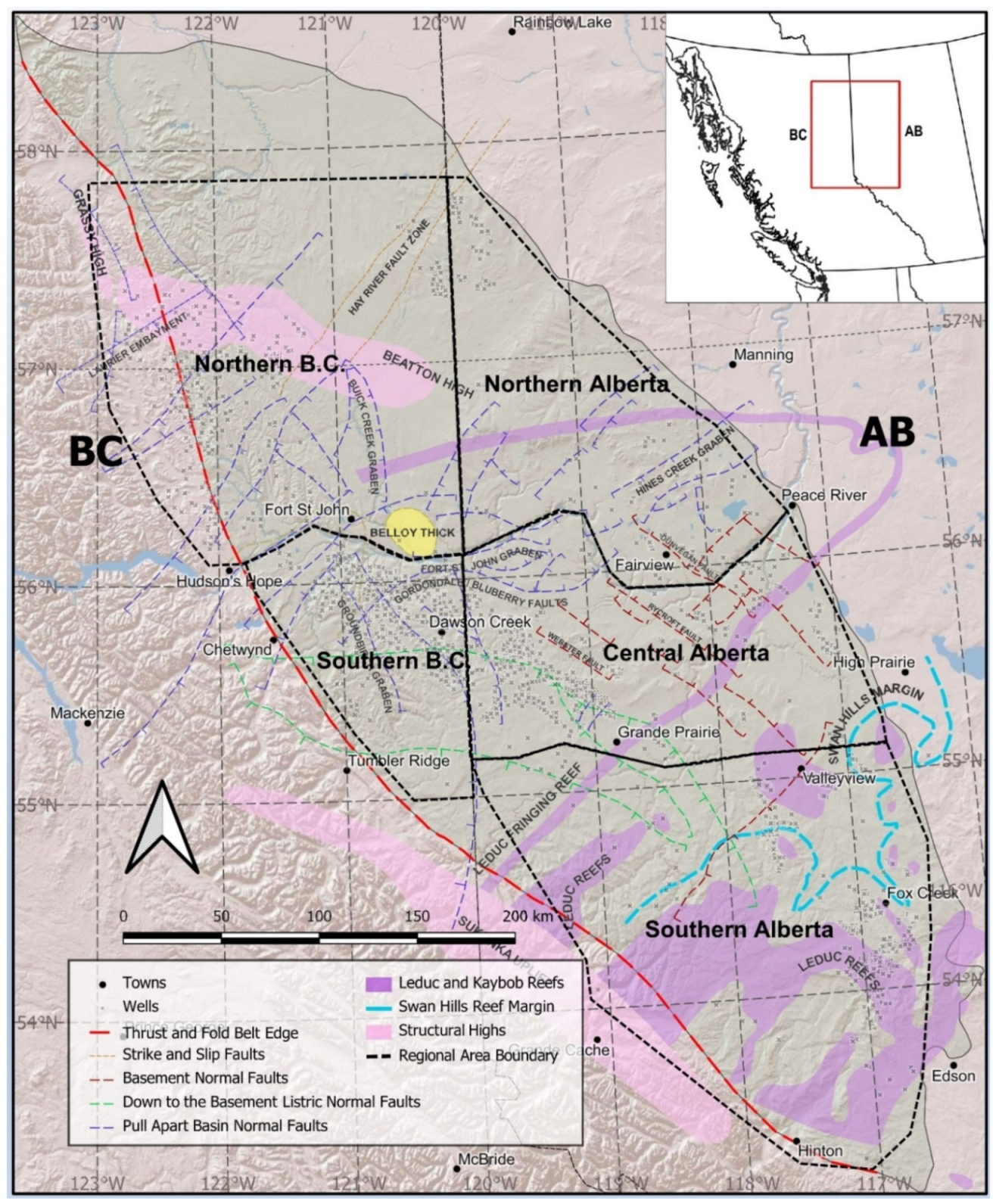
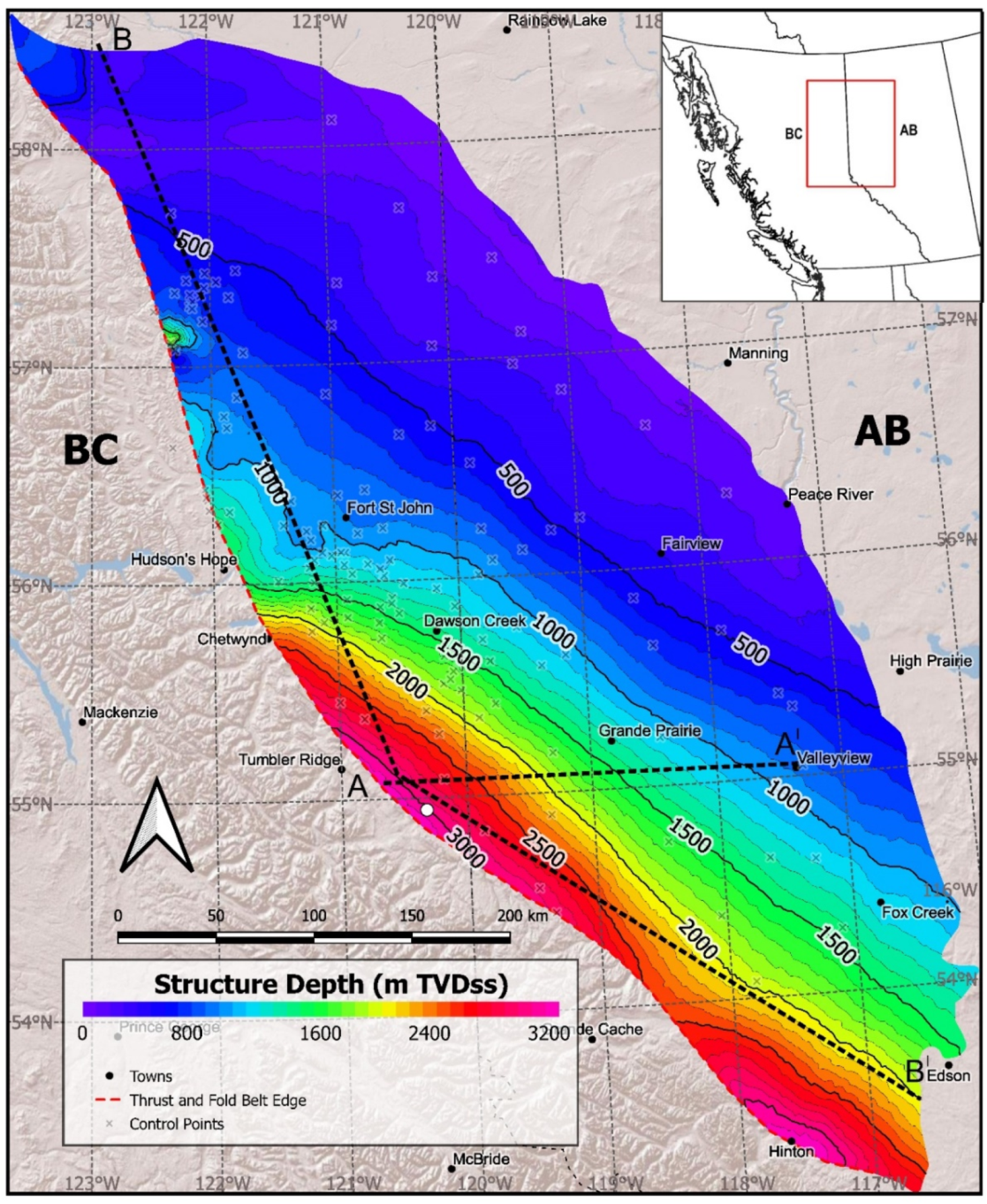
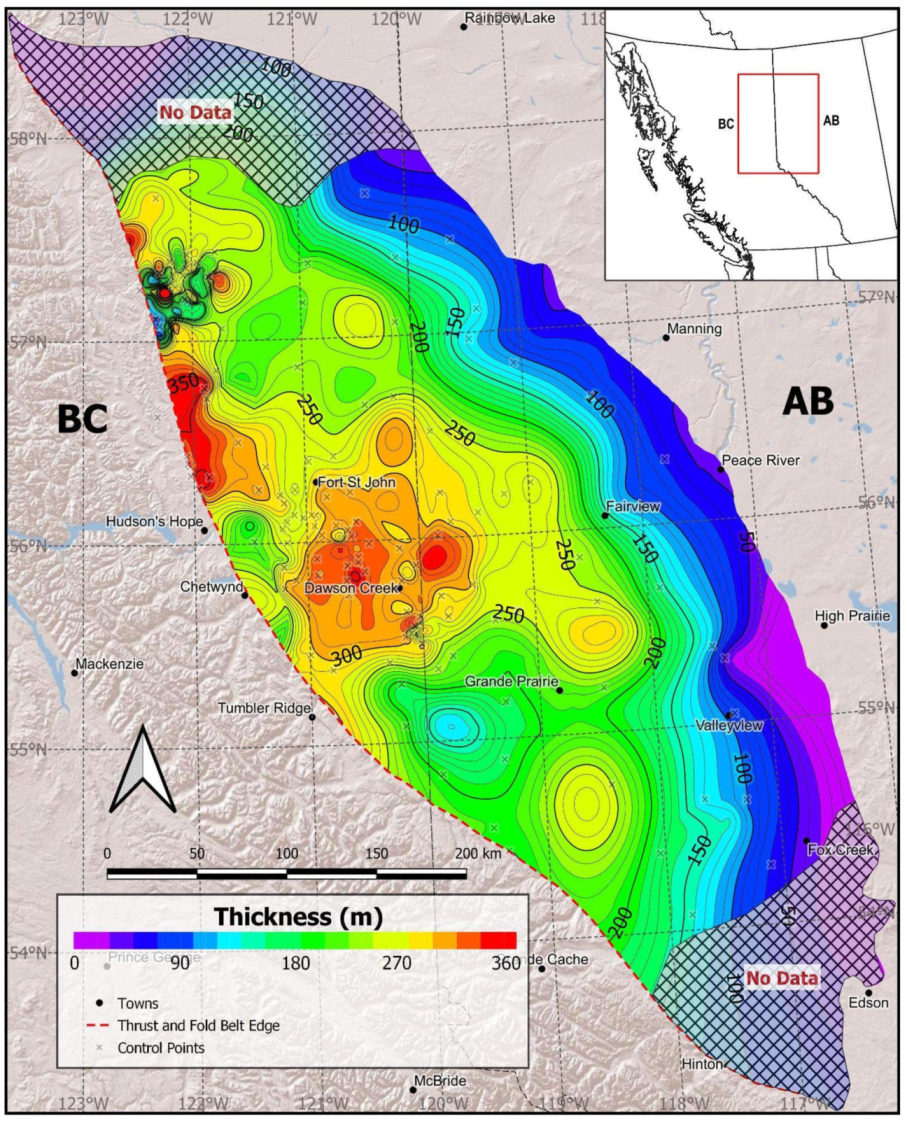
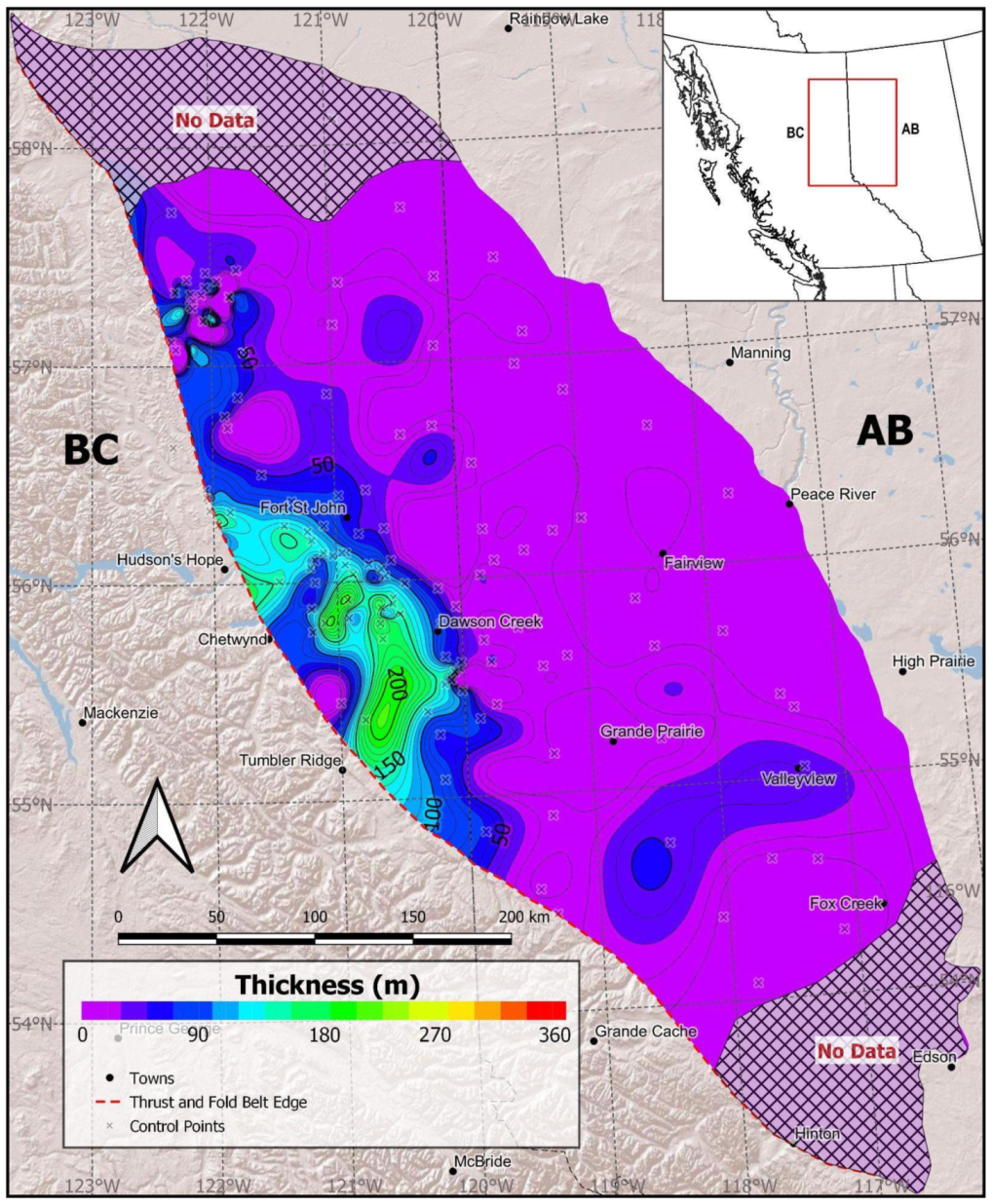


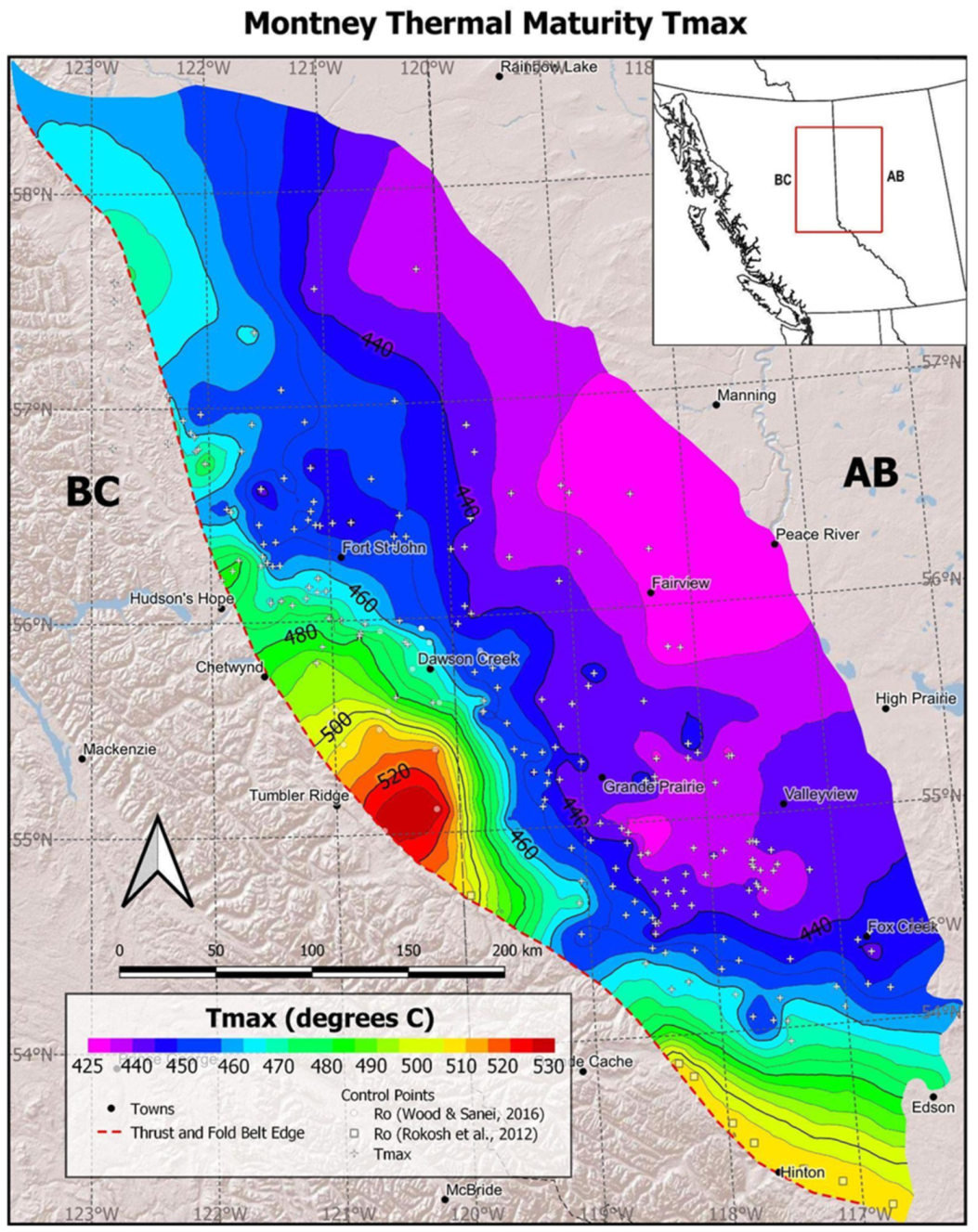
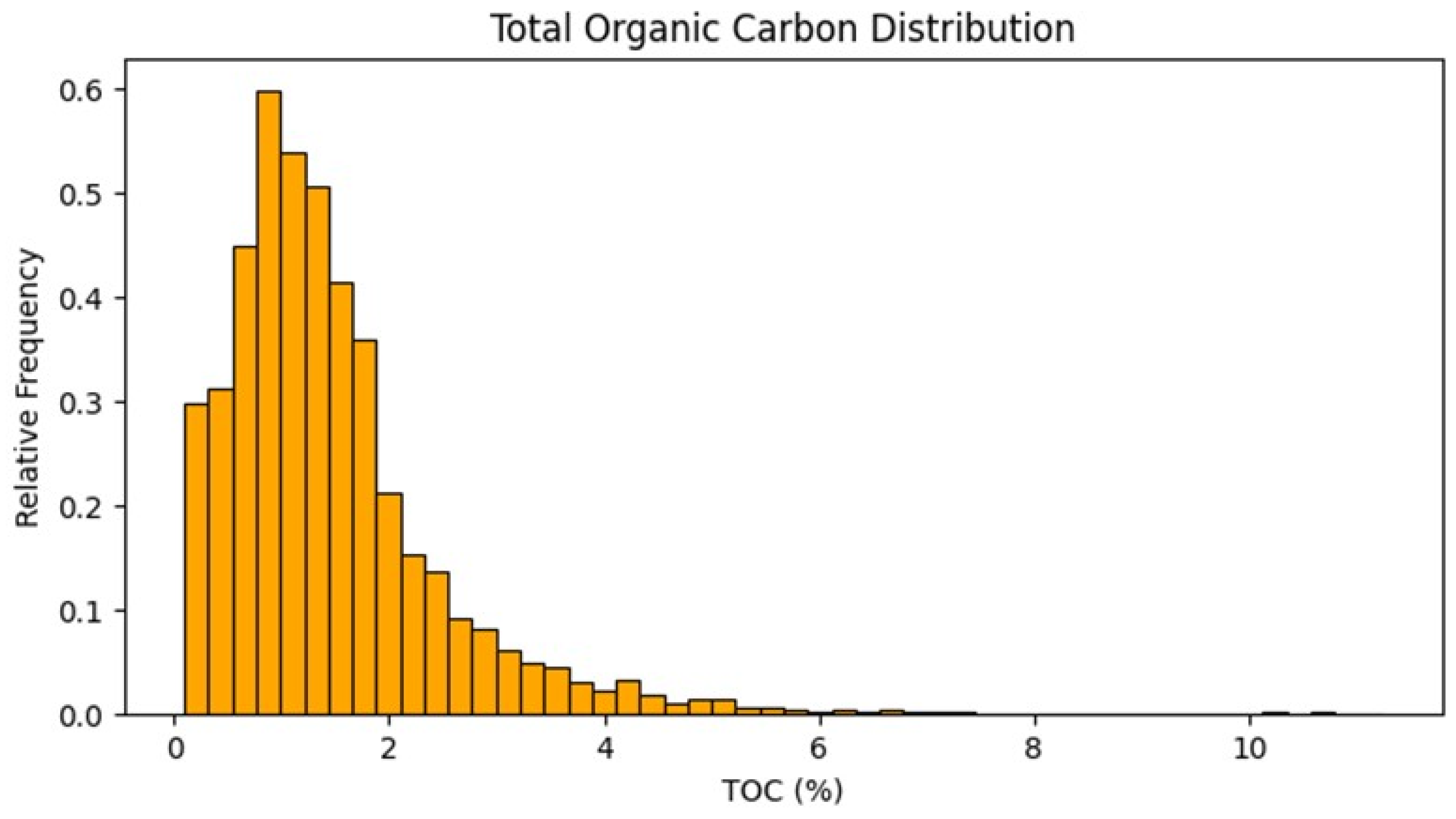
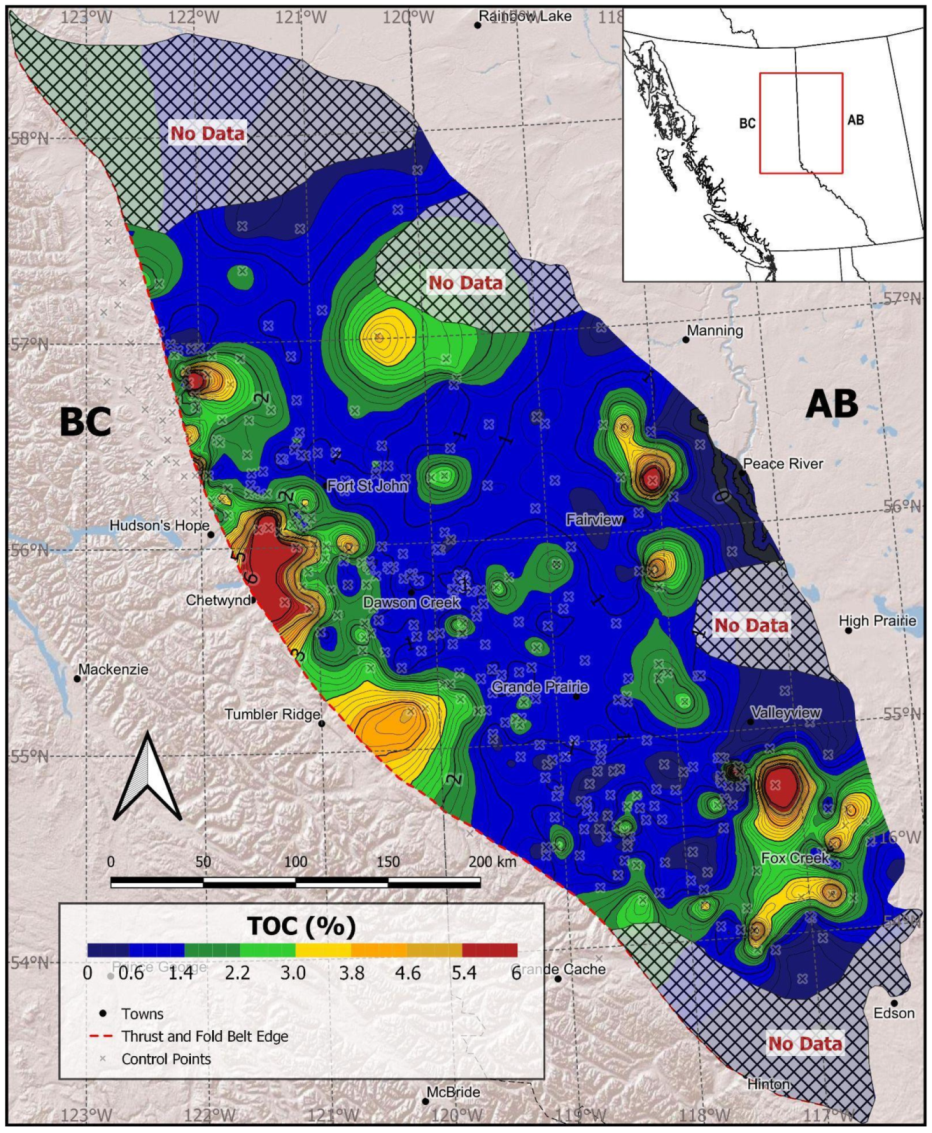



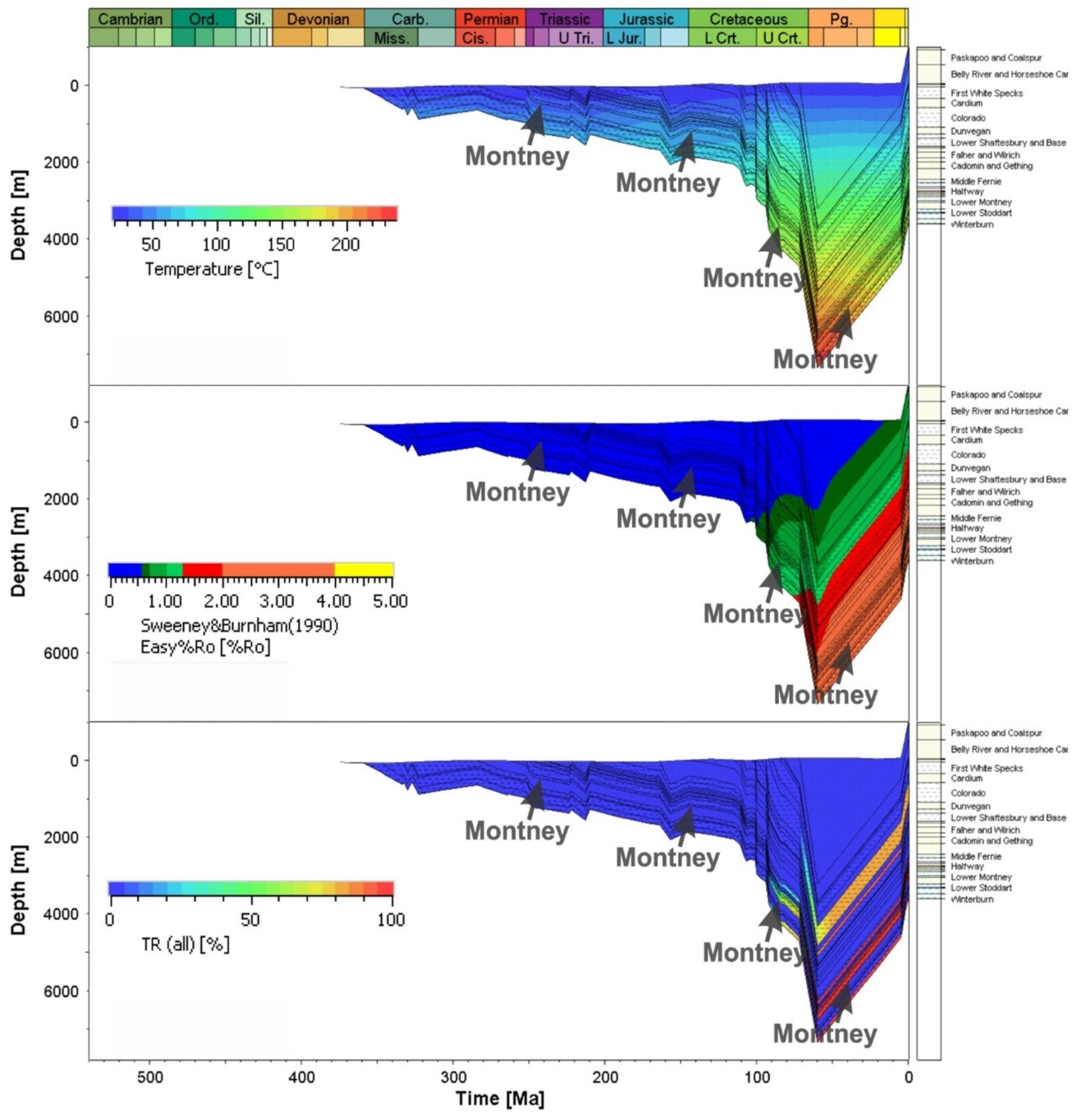

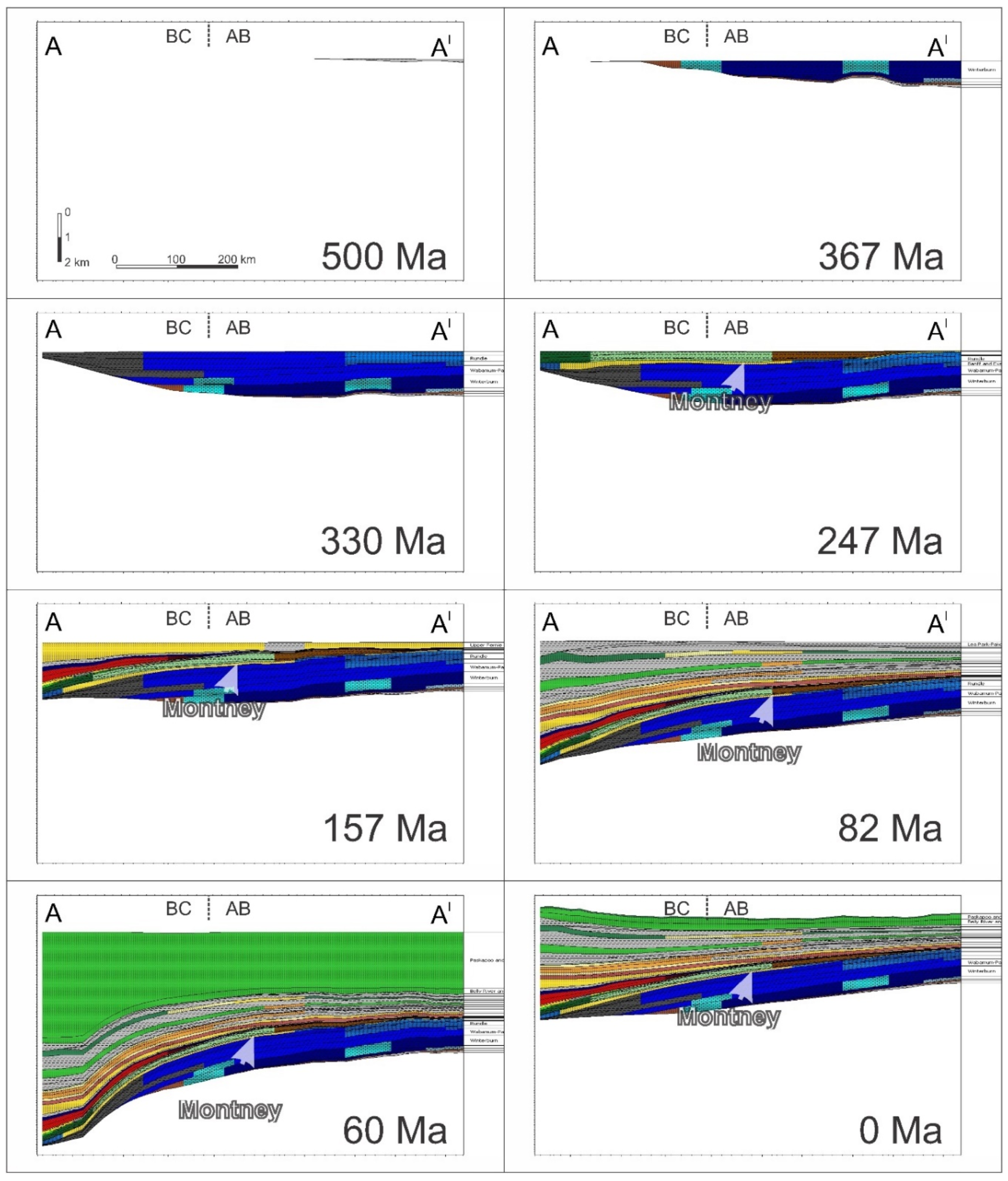
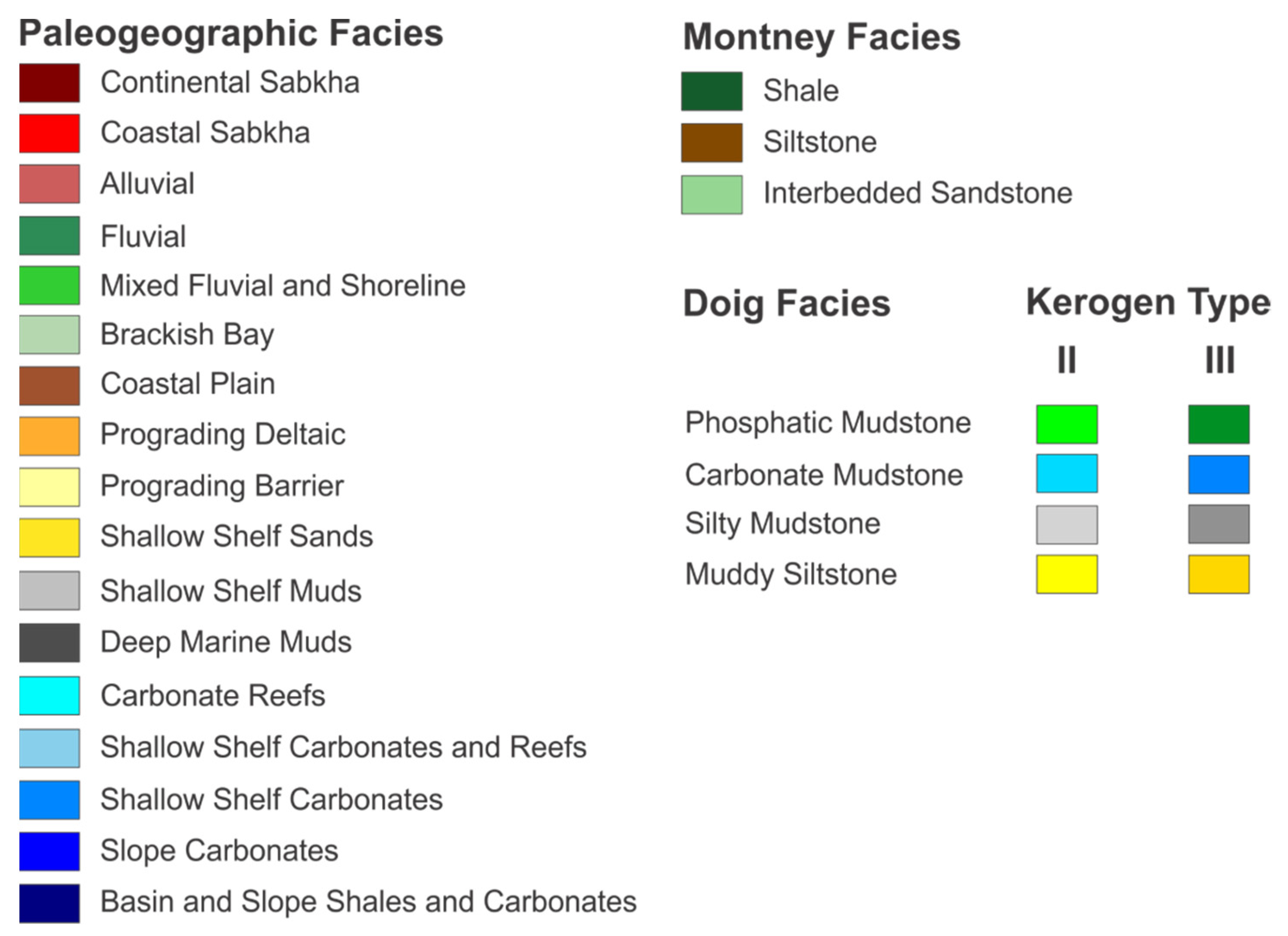


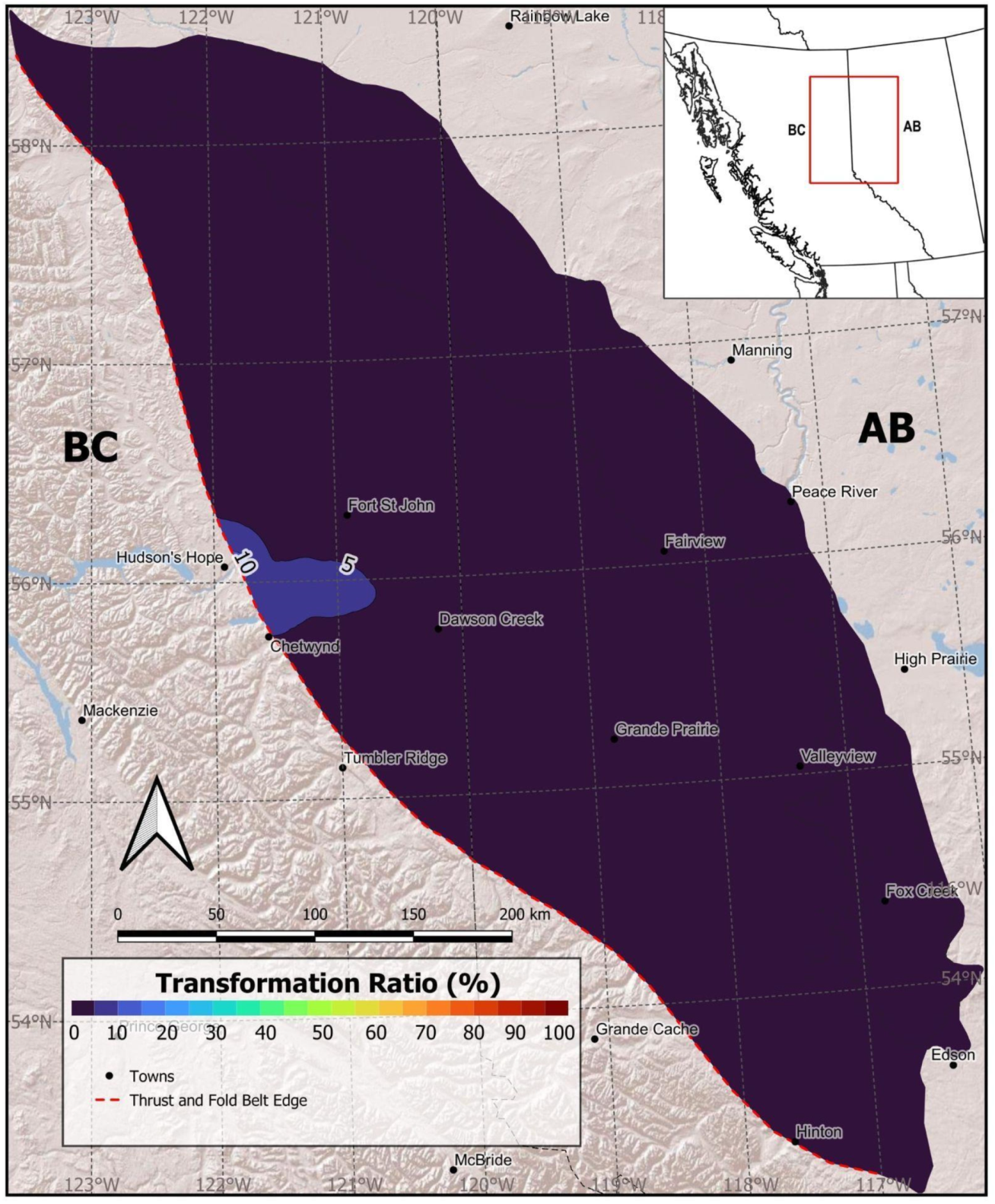




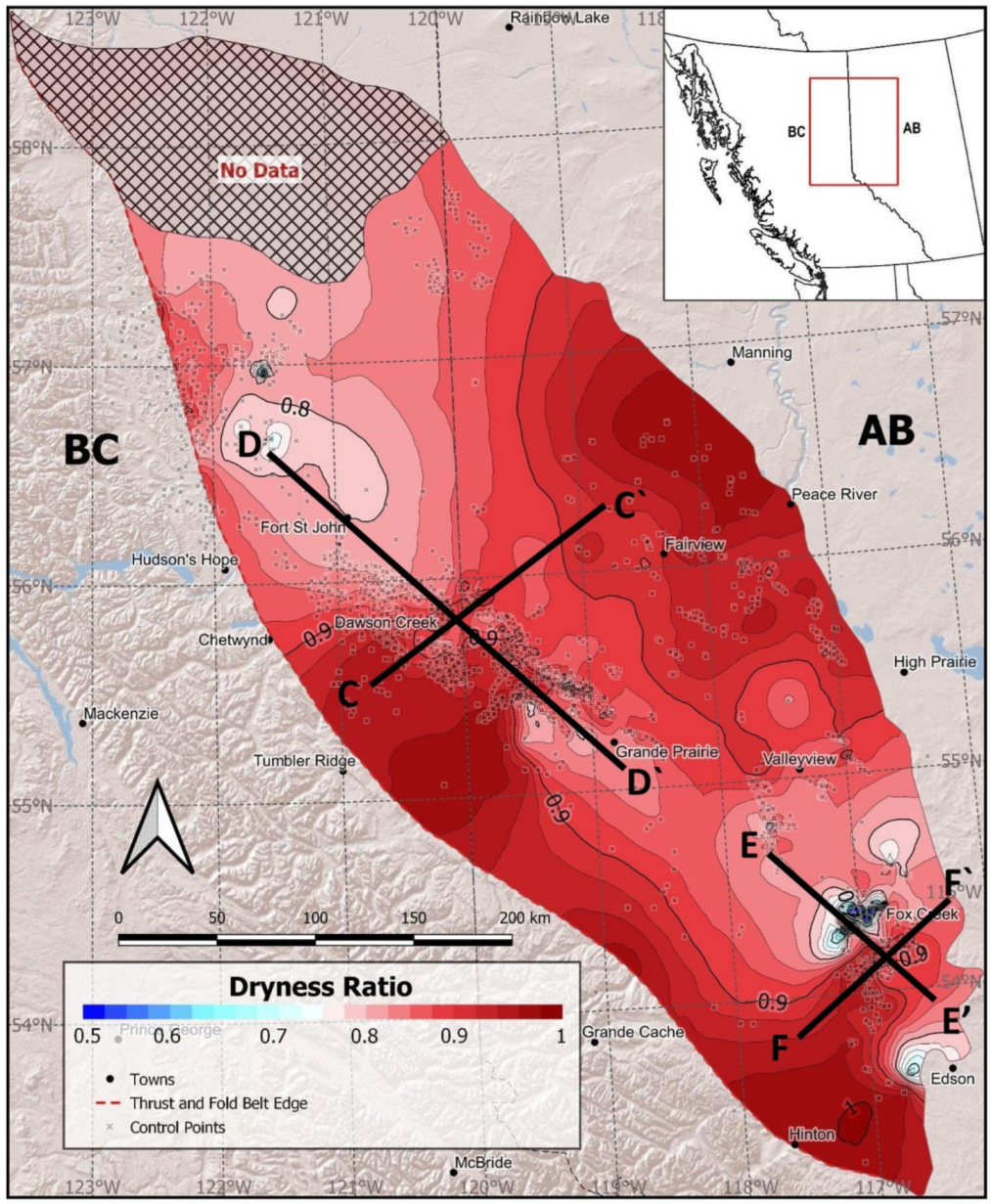
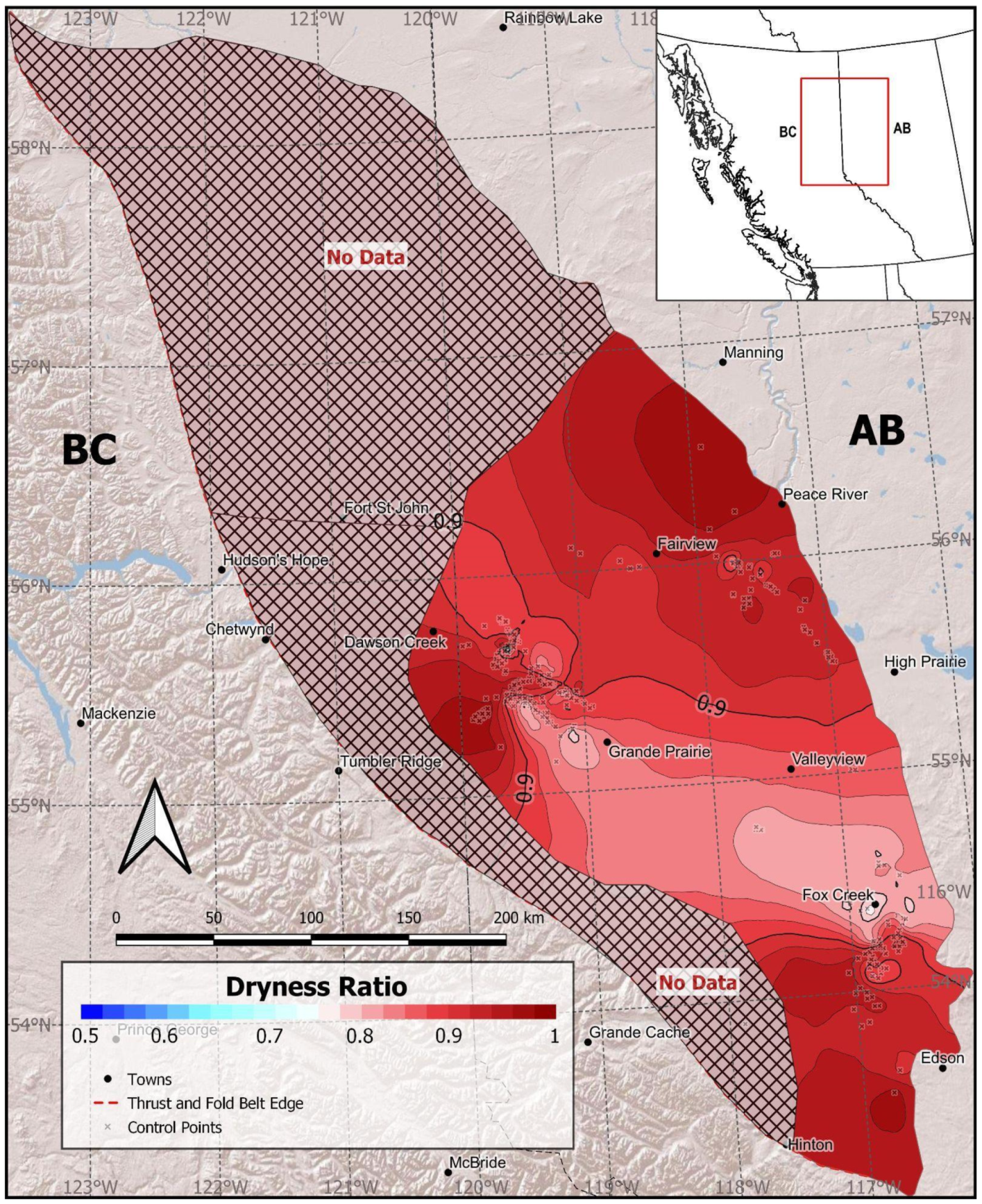

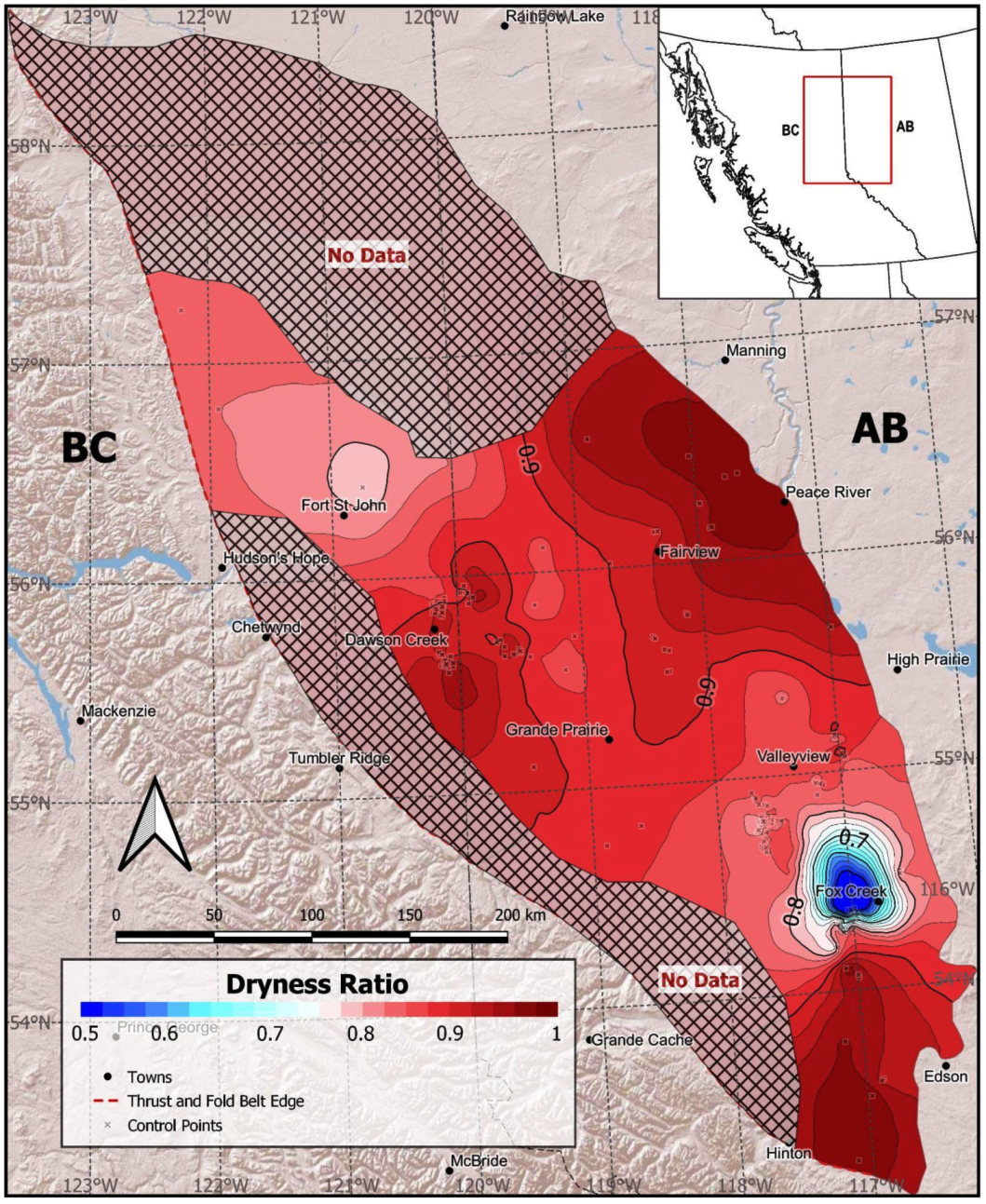

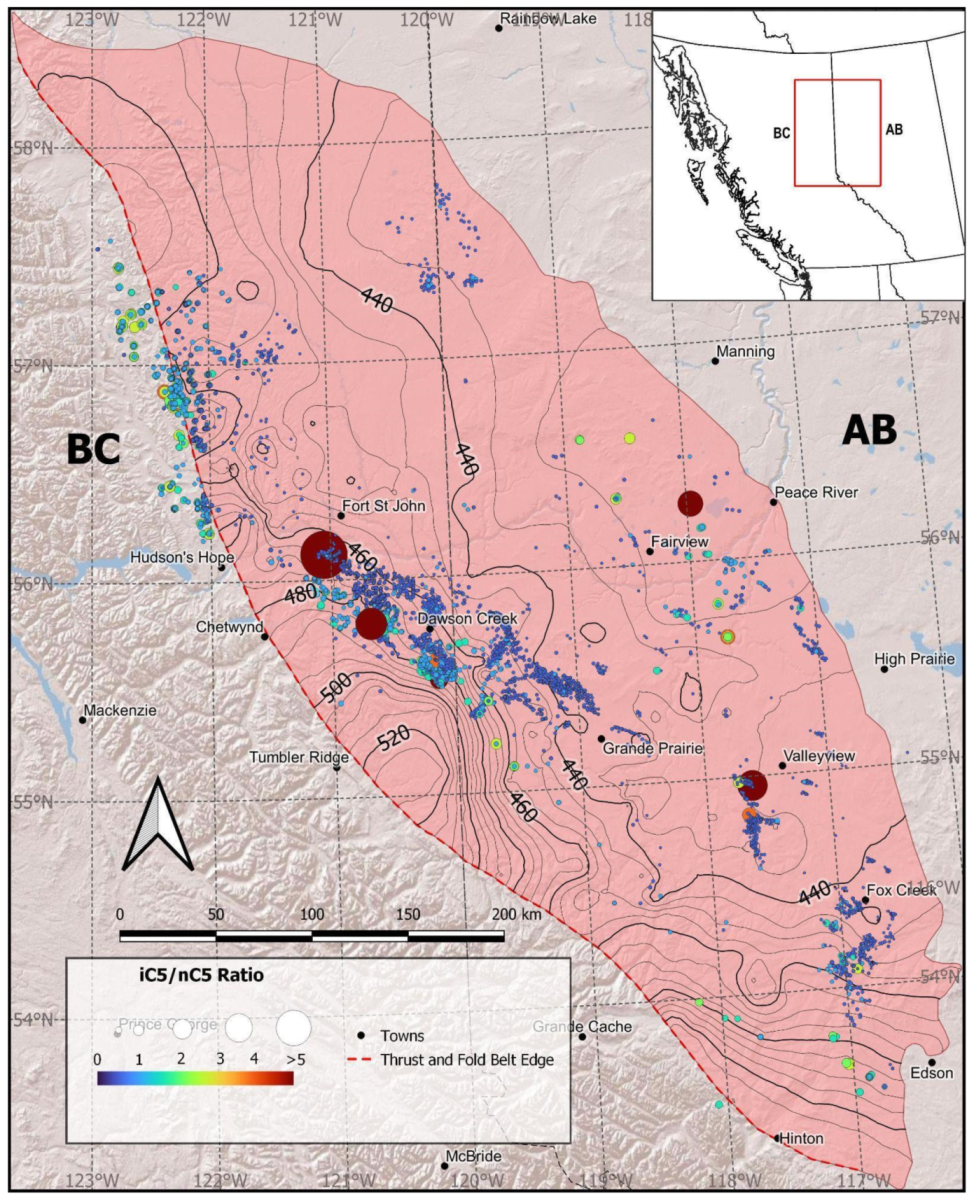
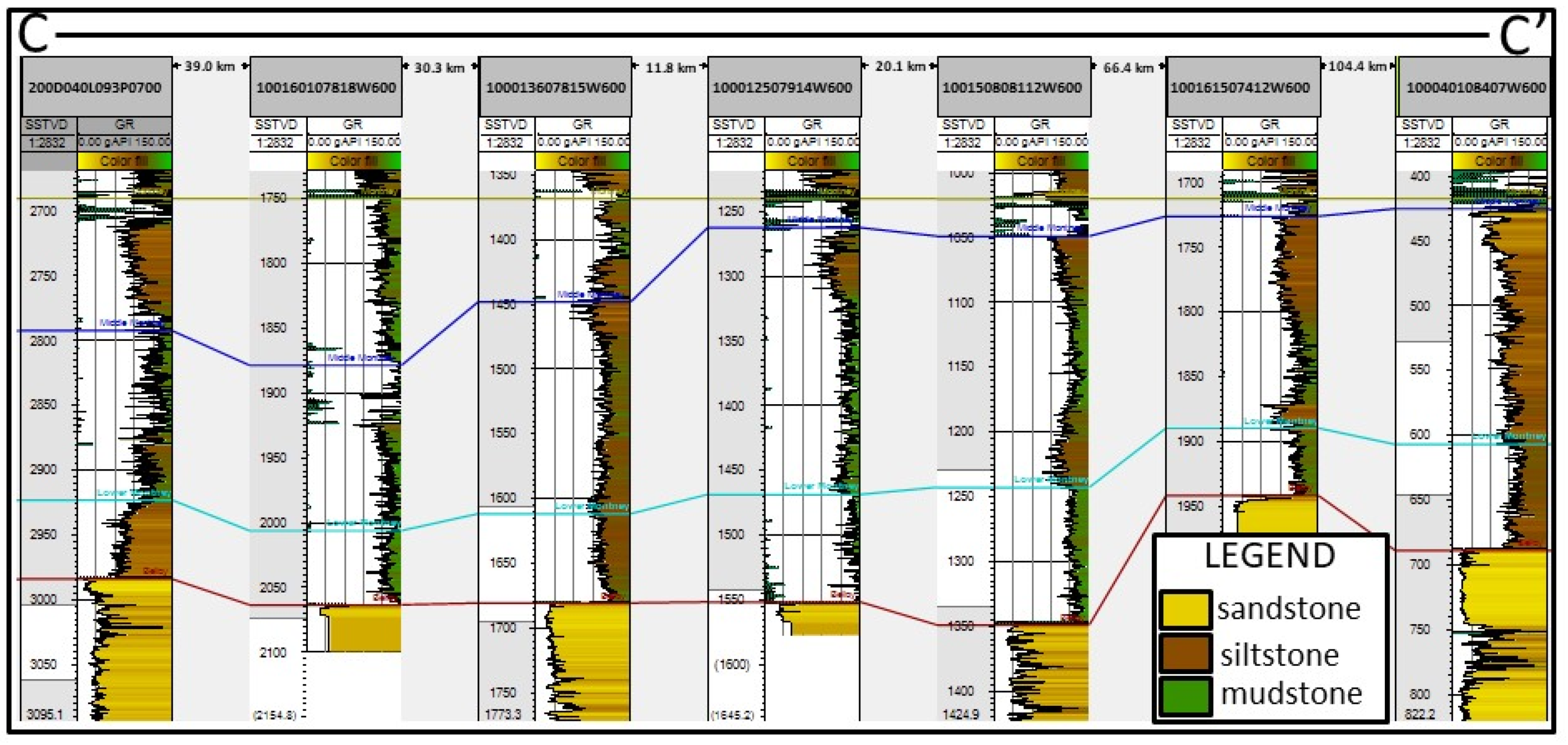



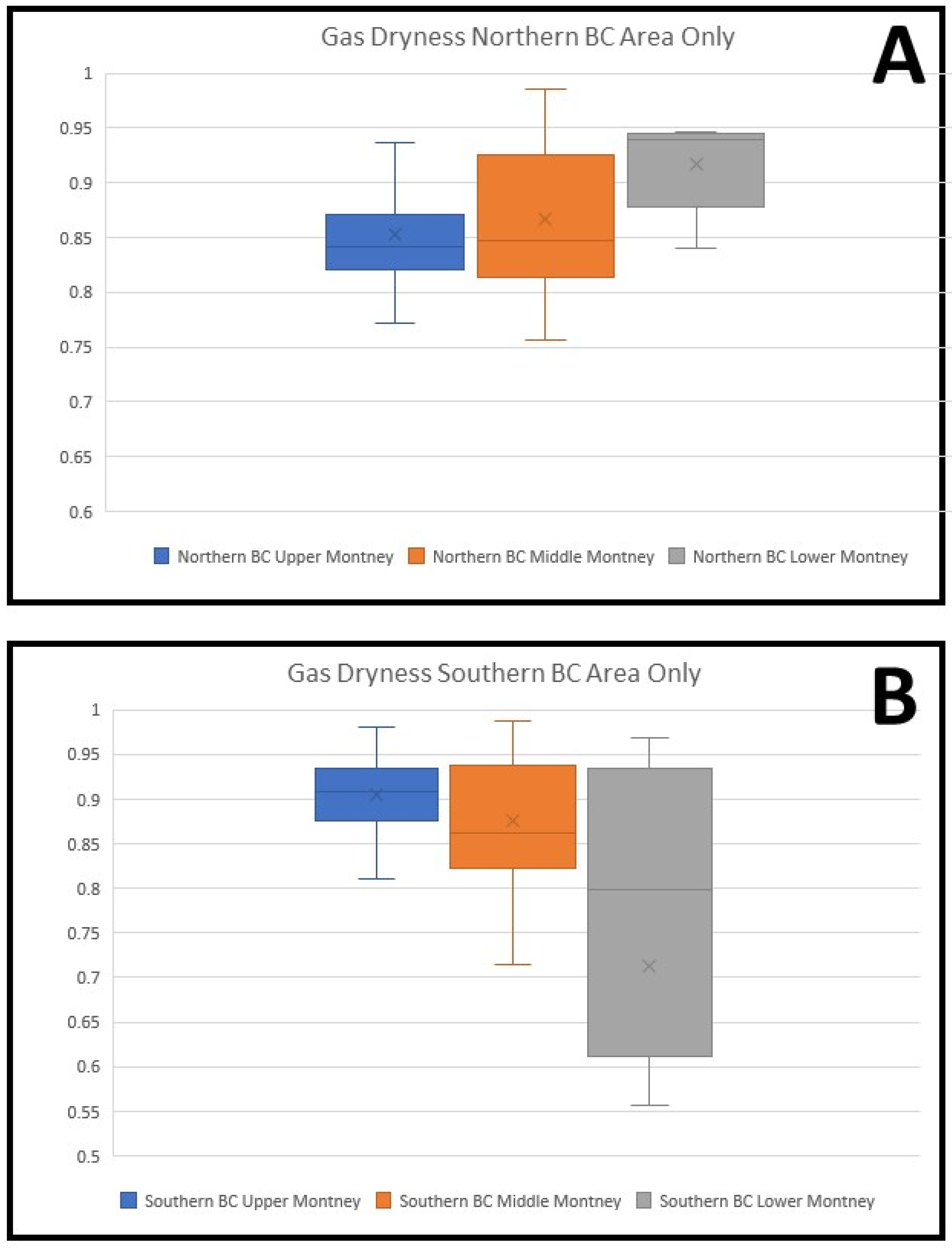
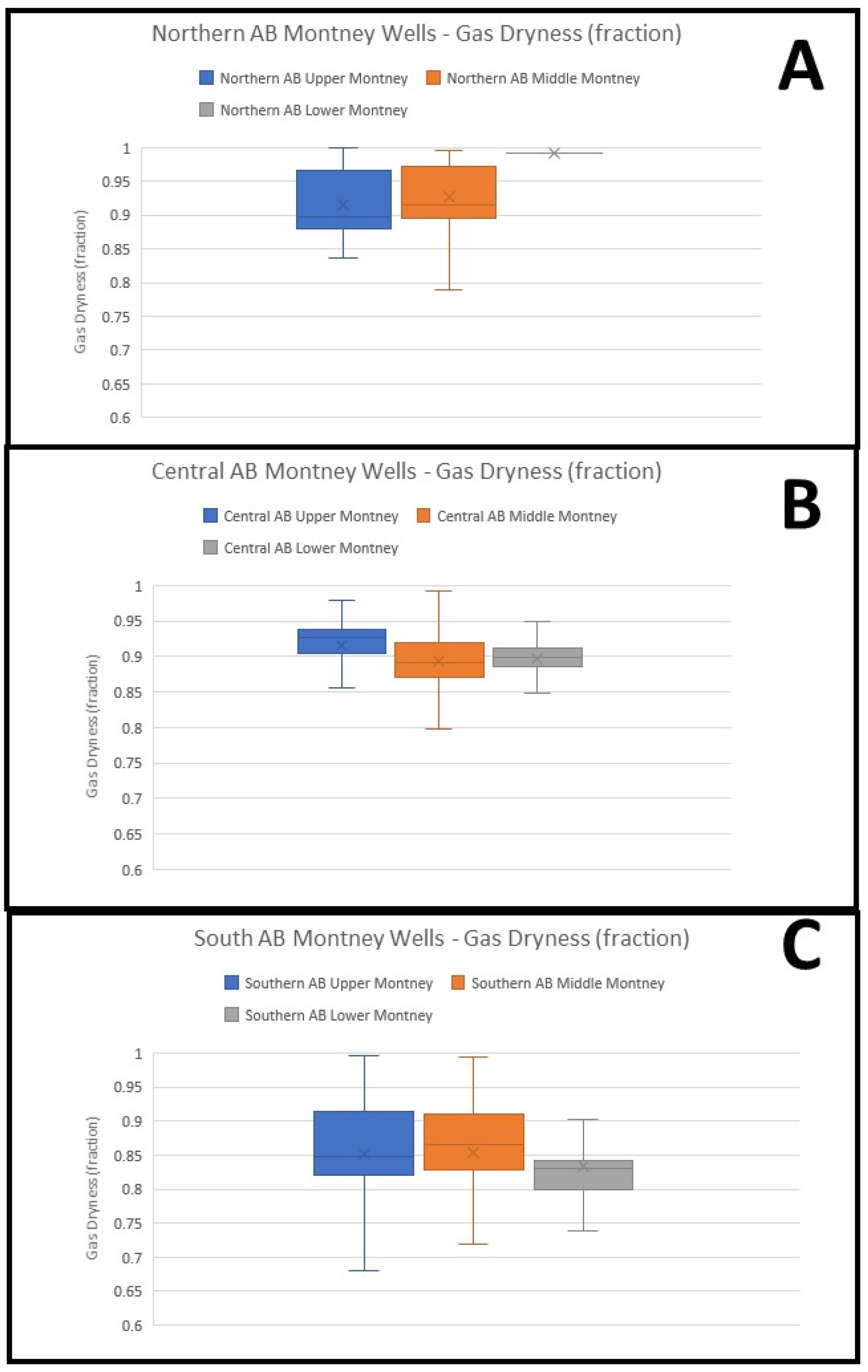
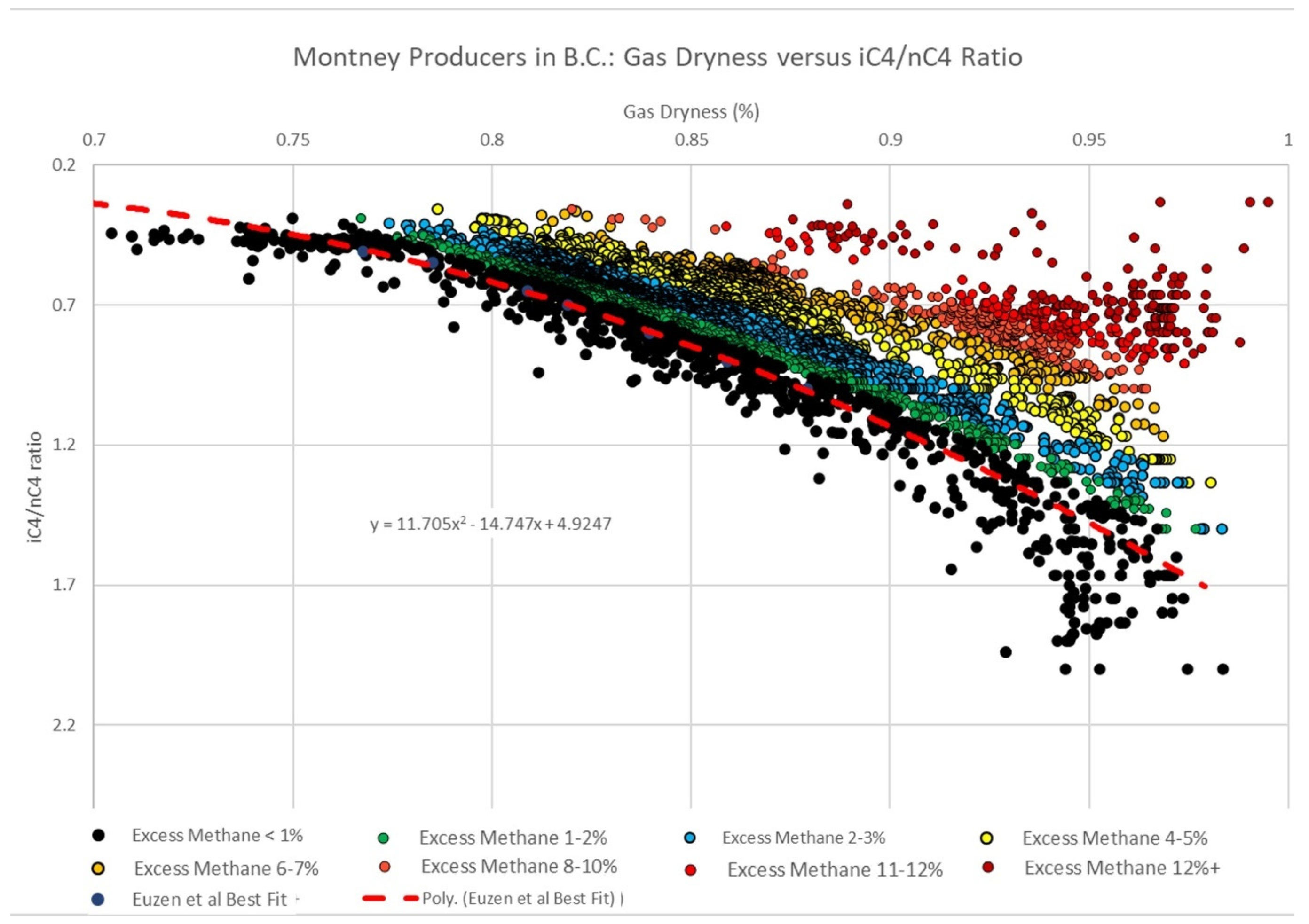
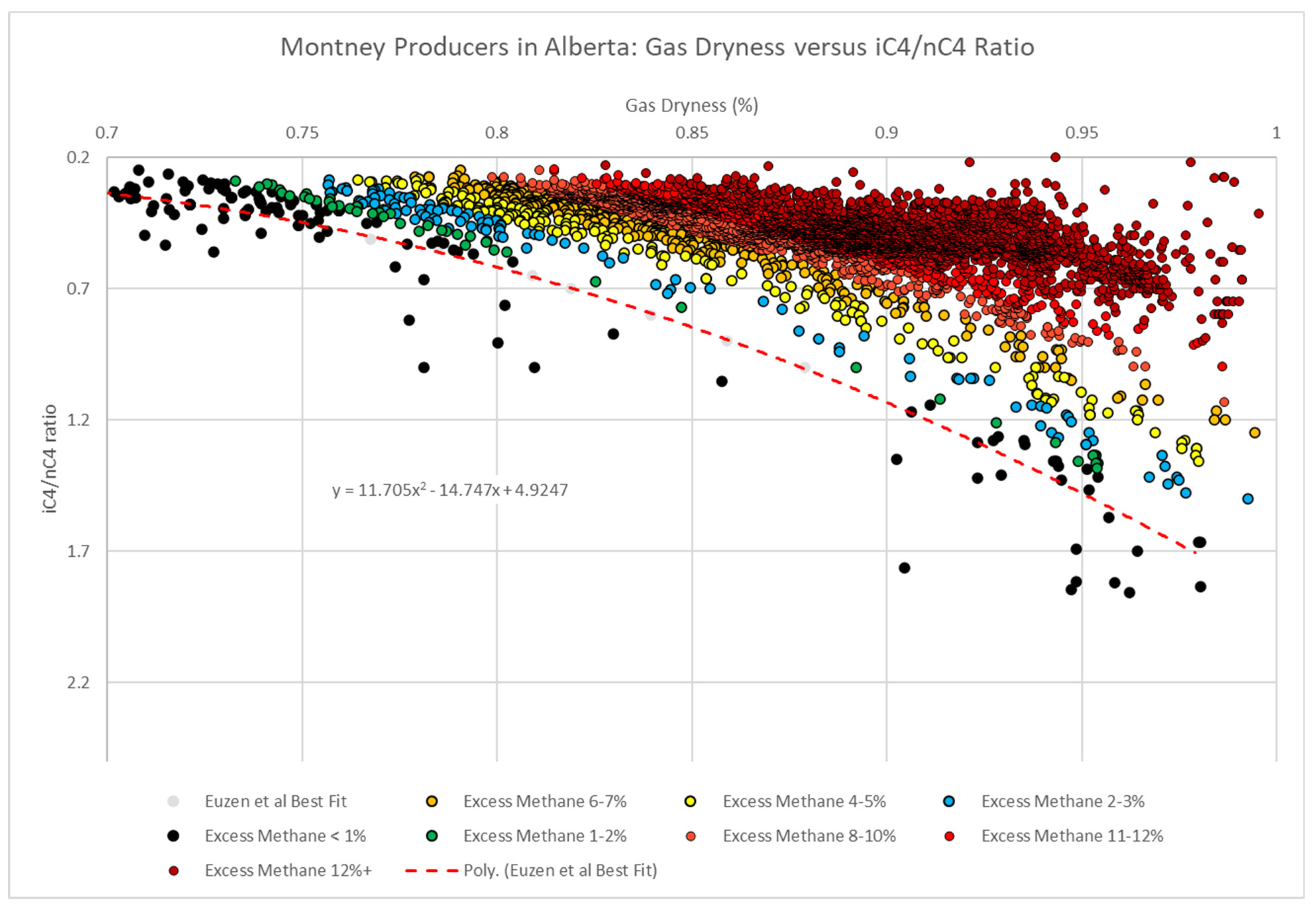
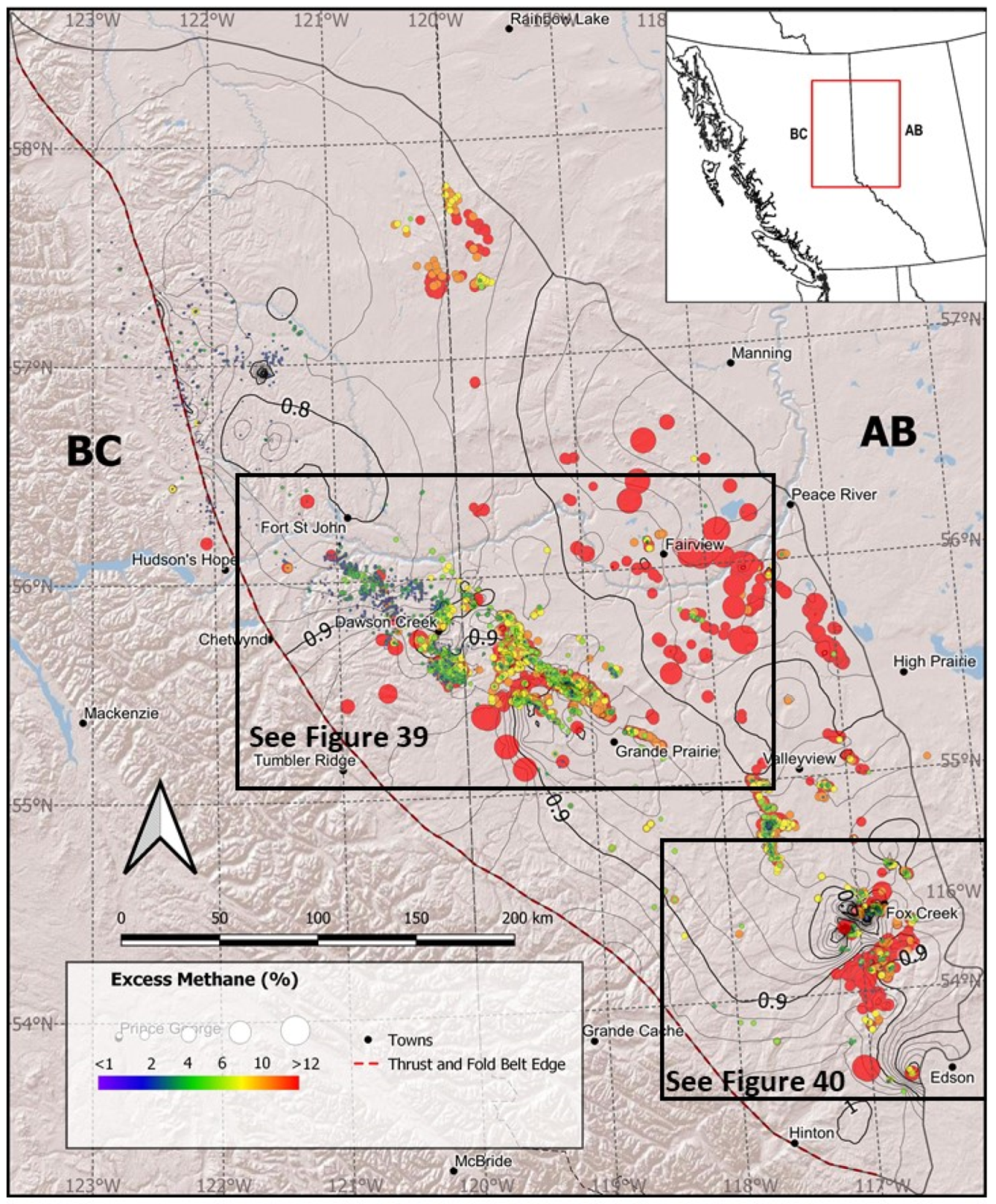

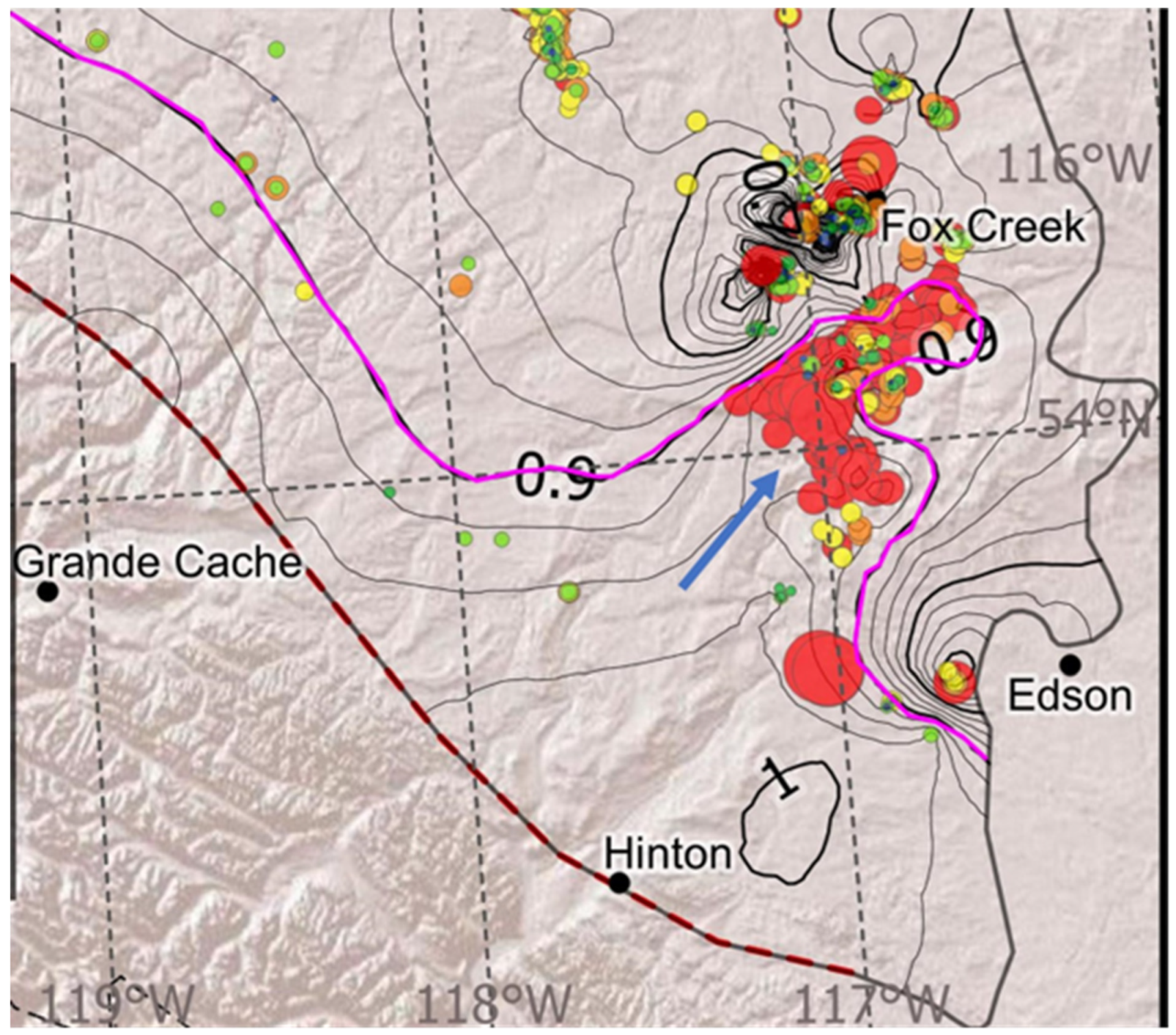
Publisher’s Note: MDPI stays neutral with regard to jurisdictional claims in published maps and institutional affiliations. |
© 2022 by the authors. Licensee MDPI, Basel, Switzerland. This article is an open access article distributed under the terms and conditions of the Creative Commons Attribution (CC BY) license (https://creativecommons.org/licenses/by/4.0/).
Share and Cite
Chalmers, G.R.L.; Lacerda Silva, P.; Bustin, A.A.; Sanlorenzo, A.; Bustin, R.M. Geology and Geochemistry of the Hydrocarbon Compositional Changes in the Triassic Montney Formation, Western Canada. Energies 2022, 15, 8677. https://doi.org/10.3390/en15228677
Chalmers GRL, Lacerda Silva P, Bustin AA, Sanlorenzo A, Bustin RM. Geology and Geochemistry of the Hydrocarbon Compositional Changes in the Triassic Montney Formation, Western Canada. Energies. 2022; 15(22):8677. https://doi.org/10.3390/en15228677
Chicago/Turabian StyleChalmers, Gareth R. L., Pablo Lacerda Silva, Amanda A. Bustin, Andrea Sanlorenzo, and R. Marc Bustin. 2022. "Geology and Geochemistry of the Hydrocarbon Compositional Changes in the Triassic Montney Formation, Western Canada" Energies 15, no. 22: 8677. https://doi.org/10.3390/en15228677



